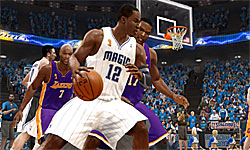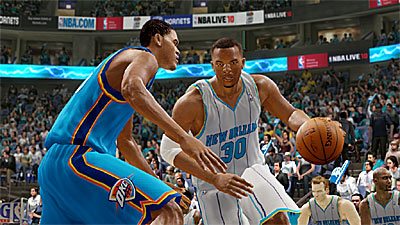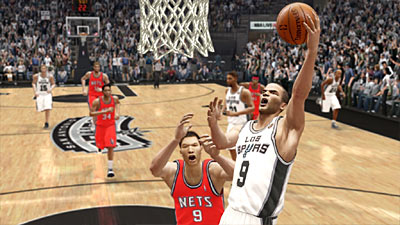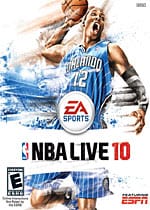Oh, to be 10… Again
NBA Live 10 could be the best ‘Live’ in about a decade if presentation was all that mattered. Developer EA Canada has clearly placed a premium on the experience gamers will have in their time spent off the court. The audio has been ramped up with arena-specific chants and realistic crowd reactions, the soundtrack is a hip-hop fan’s dream, and the new stat engine and Dynamic DNA mode might just be enough to Stump the Schwab.

Sadly, aside from a few minor tweaks (most of which are new names for old features) Live 10 does little to correct any of the most obvious issues with the series. AI defense is still porous, certain players are still automatic from beyond the arc, and, though there seems to be a new emphasis on more realistic play (specifically in the paint), this game, like most other ‘Live’ entries, feels like a glorified shootout.
The problem is that there is ultimately little balance to the game. Watching the Lakers play the Nuggets quickly descended into a Kobe-fest, as McDonald’s former spokesman dropped probably a dozen threes. Okay, leaving aside the fact the all-time leading three point percentage is about 45% (Kobe’s was somewhere in the 70’s or 80’s), he was double covered about a third of the time, not to mention the number of times he was leaning/fading away/running. Areas like this are where the game approaches NBA Jam-type farce. Essentially, if you can get your finger into the rhythm and hold the button just long enough, you can drop 10 three’s in a heartbeat with a good player. Depending on which team you’re on, it’s either very frustrating or very funny.
In my case it was frustrating. As a critic, whenever I have to rate a sports game, I place a lot of emphasis on the exhibition mode. After all, when you pick up a copy of your favorite franchise, you’re probably looking to embarrass and abuse your friends with replays of your amazing athletic exploits. I naturally decided to replay the Bulls-Celtics series from last year’s playoffs. Though the series was relatively close in reality (at least in part because of the conspicuous injury-inspired absence of Kevin Garnett), apparently the powers-that-be in the NBA Live universe make all their decisions based on higher seeds (PS, I’d love to see their brackets for March Madness 2010).

The game began realistically enough; Joakim Noah managed to drop a few lay-ups and Derrick Rose managed to control the tempo with scattered jumpers. Other than that our defense and offense were underwhelming – made sense to me. Of course, the Celtics got off to an early lead built off a 10-2 opening run, but it was the rest of the game that really put me off of the ‘Live’ experience. For the next seventeen minutes, I watched in a mix between embarrassment and dismay as Ray Allen drained three’s ad nauseum and my defenders managed to allow a consistent hole in the lane. This kind of superstar supremacy is common among EA SPORTS games, but it’s in rare form in Live 10. It was more common to see extreme plays (i.e., Kevin Garnett leaping from the free throw line to pull a rebound over two forwards and a center boxing out) than it was to see a simple, effective pick and roll. Those looking for a realistic NBA experience should look elsewhere.
Running plays, playing off ball, and getting open for the pass takes a backseat to grabbing you’re team’s franchise player and gunning your way to victory. While this isn’t as easy as in previous years’ ‘Live’ games, it is definitely a viable tactic. A competent gamer with a good NBA guard for instance could take over a game without much effort, Kobe ended up scoring about 75% of his team’s points in the aforementioned game, not unheard of, but not all that common. What’s more difficult to swallow is the fact that even mediocre players (Andrew Bynum and Jannero Pargo) can be ridiculously efficient in the right hands. I’m not sure how to deal with the problem, but then again I haven’t had over a decade and a half of fan support to find my development legs, either. This many years on the market you’d think EA would find a way to make a sincere effort in the one aspect of their game design that seems unchanged.

The changes that are present are mostly cosmetic, but they definitely add to the presentation and overall immersive feel. I am consistently impressed across the board with EA’s presentation from ‘Madden’ to ‘March Madness’ recently and ‘Live’ is no exception. In addition to the detailed “Dynamic DNA” stat tracking, the on the court action is now punctuated by the much more realistic sights and sounds of the players and fans reactions. There are even arena and player-specific cheers, intros, and animations. A three-streak by Kobe Bryant might inspire an “M-V-P” chant, a shooter might take an extra step here or there to make room for a pull up jumper, and Live 10 even records the top plays of a matchup.

These little touches add a level of ESPN-style believability to the game that helps bring the whole experience home. Even so, at times these replays along with the choice to run them after some bits of commentary, seems a little thrown together. When you see a replay of a layup after you hear something about your defense’s performance, or watch an “emotion” replay after a game in which your player sighs about a backcourt violation or a foul, you’ll understand. It’s not a real problem; it just makes these features seem less impressive.
The game’s “new” Dynamic DNA mode allows gamers to learn the tendencies of their teams and players: from shot percentages all over the court to the way a player turns out of a post up and everything in between. The mode returns from Live 2009 and can be combined with a season mode where Live players can play through any game that is actually occurring throughout the NBA’s regular season. You can even rewind to earlier points and play previous matchups in the season. Another of this year’s major draws is the Live Run mode. Live Run mode is EA’s online ‘pickup game’. Up to ten players sign on and squad up to play five on five. It’s a great idea and the farthest EA has taken this year’s ‘Live’. This of course requires the use of EA servers, so unfortunately assuming you’re an offline gamer, there’s not much here that’s going to offer a lot of variety to your game. The focus on presentation extends to the exhibition and playoff modes through the ability to alter tempo. Players can up the intensity to “playoff ” for instance to add a bit more hustle to the game, a nice touch (though I didn’t bother to spend much time with it) but it’s basically just an additional way to alter the game’s difficulty level.
Controls remain almost identical to previous years with a few noticeable exceptions. All shooting is now mapped to one button, and players can still freestyle pass and dribble. The shoulder buttons allow you to choose offensive and defensive strategy, run plays, and change matchups. Aside from that, anyone who’s played before will be very familiar with the way things work. It begs the question, why play again? EA is taking strides toward the right direction, but this one’s just not polished enough to bring in the noob’s (or the 2K converts for that matter). However, if you’re a fan and haven’t played any other entries in a while, Live 10 is a no-brainer. Oh, it’s also worth noting that if you are a hip-hop fan, the soundtrack is pretty phenomenal.
RATING OUT OF 5 RATING DESCRIPTION 4.0 Graphics
Crowds are super detailed and a great backdrop to the NBA action. Animations are more fluid, but players are still a bit blocky and they have that weird Live, polished look. 3.5 Control
Little difference between this and any other Live game, and the few “improvements” aren’t game-changers. Still, they’re fairly well done. 4.0 Music / Sound FX / Voice Acting
Always a solid part of the package, this season it could be the ‘MVP’ so to speak. 3.0 Play Value
Another year, another Live… and a little extra. At least Live Run might keep the online play interesting. 3.5 Overall Rating – Good
Not an average. See Rating legend above for a final score breakdown.
Game Features:
